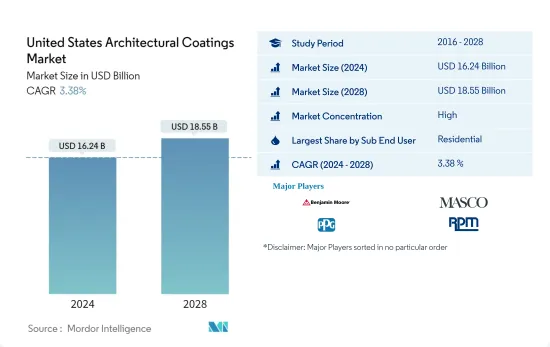 |
市场调查报告书
商品编码
1683755
美国建筑涂料:市场占有率分析、产业趋势与统计、成长预测(2025-2030 年)United States Architectural Coatings - Market Share Analysis, Industry Trends & Statistics, Growth Forecasts (2025 - 2030) |
||||||
※ 本网页内容可能与最新版本有所差异。详细情况请与我们联繫。
预计 2024 年美国建筑涂料市场规模为 162.4 亿美元,到 2028 年将达到 185.5 亿美元,预测期内(2024-2028 年)的复合年增长率为 3.38%。

主要亮点
- 按最终用户分類的最大细分市场:住宅:由于住宅建筑的数量比商业建筑多,因此住宅领域的建筑涂料消费量更高。
- 以科技分類的最大细分市场-水性涂料:在美国,由于环保署(EPA)的严格监管和大量消费者对环保健康产品的偏好,水性涂料的消费量和成长率很高。
- 树脂最大的市场:丙烯酸:丙烯酸是主要的树脂类型,因为它成本低且可用于许多水性涂料。美国市场水性涂料的使用也正在增加。
美国建筑涂料市场的趋势
按终端用户细分,住宅是最大的。
- 建筑涂料的成长自 2016 年以来一直在下降,但在 2020 年有所恢復。 2020 年的成长主要是由于消费者待在家中完成 DIY计划导致 DIY 领域销售额大幅成长。住宅存量的老化是市场需求的主要驱动力,平均房龄从 2001 年的约 31 年达到 2019 年的 41 年。
- 该国住宅部门占比最高,约78-79%。但这趋势在2020年发生了明显变化,住宅领域的重新粉刷需求大幅增加,而商业领域的重新粉刷需求则大幅减少,导致商业领域的占比降至17.4%以下。
- 预计商业部门的份额将在预测期内恢復,但由于住宅部门的持续需求,短期内可能无法达到大流行前的水平。
美国建筑涂料产业概况
美国建筑涂料市场相当集中,前五大公司占了77.70%的市场。该市场的主要企业是:Benjamin Moore & Co.、Masco Corporation、PPG Industries, Inc.、RPM International Inc. 和 The Sherwin-Williams Company(按字母顺序排列)。
其他福利
- Excel 格式的市场预测 (ME) 表
- 3 个月的分析师支持
目录
第 1 章执行摘要和主要发现
第 2 章 简介
- 研究假设和市场定义
- 研究范围
- 调查方法
第三章 产业主要趋势
- 占地面积趋势
- 法律规范
- 价值链与通路分析
第 4 章 市场细分
- 子终端用户
- 商业的
- 住宅
- 技术领域
- 溶剂型
- 水性
- 树脂
- 丙烯酸纤维
- 醇酸
- 环氧树脂
- 聚酯纤维
- 聚氨酯
- 其他树脂类型
第五章 竞争格局
- 重大策略倡议
- 市场占有率分析
- 业务状况
- 公司简介
- Beckers Group
- Benjamin Moore & Co.
- Diamond Vogel
- Dunn-Edwards Corporation
- Kelly-Moore Paints
- Masco Corporation
- PPG Industries, Inc.
- RPM International Inc.
- The Sherwin-Williams Company
第六章 执行长的关键策略问题
第七章 附录
- 世界概况
- 概述
- 五力分析框架
- 全球价值链分析
- 市场动态(DRO)
- 资讯来源和进一步阅读
- 图片列表
- 关键见解
- 资料包
- 词彙表
The United States Architectural Coatings Market size is estimated at USD 16.24 billion in 2024, and is expected to reach USD 18.55 billion by 2028, growing at a CAGR of 3.38% during the forecast period (2024-2028).

Key Highlights
- Largest Segment by End-user - Residential : Compared to commercial building stock, the country's high volume of residential building stock resulted in high architectural paint consumption from the residential sector.
- Largest Segment by Technology - Waterborne : High EPA regulations and consumer preference toward green and healthy products contributed to the high consumption and growth of waterborne coatings in the United States.
- Largest Segment by Resin - Acrylic : Acrylic is a leading type of resin, owing to its low cost and high usage in waterborne coatings. Waterborne coatings are also increasingly used in the US market.
US Architectural Coatings Market Trends
Residential is the largest segment by Sub End User.
- The growth rate of architectural coatings declined since 2016 before bouncing back in 2020. The growth registered in 2020 was due to a huge sales increase from the DIY segment, driven by consumers "nesting" at home and completing DIY projects. The aging housing stock, which reached an average age of 41 years in 2019 from around 31 years in 2001, was a major driver for the market demand.
- The country's residential sector held the highest share, registering around 78-79%. However, this trend changed drastically in 2020 due to a major increase in residential repaint demand in parallel with a huge decline in the commercial sector, thus reducing the commercial sector's share to less than 17.4%.
- Though the commercial sector's share is expected to recover during the forecast period, it may not reach the pre-pandemic levels in the short term due to sustained demand in the residential segment.
US Architectural Coatings Industry Overview
The United States Architectural Coatings Market is fairly consolidated, with the top five companies occupying 77.70%. The major players in this market are Benjamin Moore & Co., Masco Corporation, PPG Industries, Inc., RPM International Inc. and The Sherwin-Williams Company (sorted alphabetically).
Additional Benefits:
- The market estimate (ME) sheet in Excel format
- 3 months of analyst support
TABLE OF CONTENTS
1 EXECUTIVE SUMMARY & KEY FINDINGS
2 INTRODUCTION
- 2.1 Study Assumptions & Market Definition
- 2.2 Scope of the Study
- 2.3 Research Methodology
3 KEY INDUSTRY TRENDS
- 3.1 Floor Area Trends
- 3.2 Regulatory Framework
- 3.3 Value Chain & Distribution Channel Analysis
4 MARKET SEGMENTATION
- 4.1 Sub End User
- 4.1.1 Commercial
- 4.1.2 Residential
- 4.2 Technology
- 4.2.1 Solventborne
- 4.2.2 Waterborne
- 4.3 Resin
- 4.3.1 Acrylic
- 4.3.2 Alkyd
- 4.3.3 Epoxy
- 4.3.4 Polyester
- 4.3.5 Polyurethane
- 4.3.6 Other Resin Types
5 COMPETITIVE LANDSCAPE
- 5.1 Key Strategic Moves
- 5.2 Market Share Analysis
- 5.3 Company Landscape
- 5.4 Company Profiles
- 5.4.1 Beckers Group
- 5.4.2 Benjamin Moore & Co.
- 5.4.3 Diamond Vogel
- 5.4.4 Dunn-Edwards Corporation
- 5.4.5 Kelly-Moore Paints
- 5.4.6 Masco Corporation
- 5.4.7 PPG Industries, Inc.
- 5.4.8 RPM International Inc.
- 5.4.9 The Sherwin-Williams Company
6 KEY STRATEGIC QUESTIONS FOR ARCHITECTURAL COATINGS CEOS
7 APPENDIX
- 7.1 Global Overview
- 7.1.1 Overview
- 7.1.2 Porter's Five Forces Framework
- 7.1.3 Global Value Chain Analysis
- 7.1.4 Market Dynamics (DROs)
- 7.2 Sources & References
- 7.3 List of Tables & Figures
- 7.4 Primary Insights
- 7.5 Data Pack
- 7.6 Glossary of Terms






